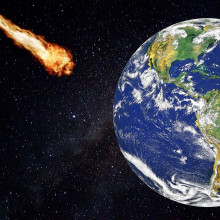This week on the Naked Scientists; why, after many years, chickenpox vaccines for children finally look set to become the norm in the UK. Also, will artificial intelligence beat our weather forecasters? And can comets seed the biological building blocks of life to planets like Earth?
In this episode

00:55 - Vaccine regulator advises chickenpox jab for UK children
Vaccine regulator advises chickenpox jab for UK children
The UK’s leading authority on vaccinations, the joint committee on vaccination and immunisation, has advised that all children in the UK should be given a chickenpox jab at 12 and 18 months of age. Until now, parents have had to go privately and pay to protect their child against the virus.
Our regular host, Dr Chris Smith, is a consultant virologist and has the story…
Chris - Chickenpox is one of the most common infections in humans. If I picked a person at random off the street here in the UK, but equally this is going to be true in the majority of other Western countries, I've got a 90% chance that I'll pick someone that has a history of having had chickenpox. And in fact, if I then investigate, I'll find that in those people they've still got chickenpox because it's one of the herpes viruses. Those viruses, characteristically, once you've got them, herpes is for life. It lives in certain parts of your body for the rest of your life. And in the case of chickenpox, that means the nervous system. So the chickenpox virus causes an acute disease, which is the spotty itchy rash that we see characteristically in kids because by the time they go to school in the UK, about 90% of children have already had it. But because it then survives in your nervous system for the rest of your life, it can periodically come back as a different manifestation, but equally infectious: that's shingles and it's painful. It's confined to one part of the body and you can obviously infect other people from it. So it's still a threat and can be dangerous in certain parts of the body as well. This is a fairly trivial infection for the vast majority of people, but for some people it can be a threat, particularly the elderly and pregnant women and also people with poor immune systems.
Will - If it's been so well known that it's so widespread and for such a long time, why is this vaccine being pushed to be free now?
Chris - The original decision that was taken by our authorities in the UK, they took the view that, with such high seroprevalence, 90% of people having had the infection, and the fact that if you've got virus circulating in the population you are also topping up people's immunity almost like a booster for free, and because people are running into the infection periodically which helps to protect people from shingles, they suggested we didn't need to pursue vaccination. Other countries took a different view; Australia, America, Canada, Germany, they did go down the route of using this vaccine. There is now a couple of vaccines that we use. They're very safe. They are live attenuated vaccines, they're weakened forms of the chickenpox virus, which shows the immune system what the virus can do, how it works, and therefore how to make an immune response against it - but it doesn't make a person ill and then you have protection for the long term. Those countries that have gone down this route have successfully proved that you don't have a problem with shingles in older people, and we also have vaccines against shingles now as well. So really the reasons not to do this are being taken away and it leaves the argument that when you do have chickenpox in children, whilst it's a trivial infection for the vast majority of people and can be a worry for women who haven't had it and get pregnant, it still means it's very disruptive to a person's family because, if you get a succession of cases, people end up having to take time off work, for example. This can be weeks at a time because the period of infectivity is a week and if you have a child with it and then a child who gets it, and then an adult who gets it, you might be off work for a month. When you do the economics of this, many countries have argued it's much cheaper to offer a vaccine to a young child and protect them from having to put up with the infection and then the family having to have problems caused by that child with the infection. It's much cheaper in the long run to do this and protect them with this vaccine than to just run the gamut of having chickenpox and having to put up with the consequences.
Will - The difference between the current status and the status that they're hoping for is that it's going from a paid vaccination to a free one. Is this free in other countries? Are the UK behind the pace as it were?
Chris - At the moment, while the vaccine is licensed for us to give it to young children, many trials and millions of doses have proven that it's safe and effective. Because it wasn't approved by our health approval bodies as a routine vaccine, parents could access it, but they would have to pay for it. It was costing about 200 pounds or about 300-400 dollars for them to do that. If we move towards this becoming part of the standard vaccination regime for young people, then it will be free because our vaccines are offered at the point of delivery for free. Other countries with other healthcare systems will obviously have a different approach. Different countries with totally different healthcare systems and different funding models will have some elements that are free, some that are subsidised, some that are chargeable. So really it will matter according to where in the different jurisdictions a person is where they're trying to access the care. But what it means for the UK is, if they do put this as part of the routine vaccine programme, it will be free.
Will - As a final point, as you said, eradication would take a lifetime and it's impossible to think that it may happen completely. But should this come into place and the uptake is good and people are keen for it, what would you expect the outcome to be? Do you think this is a good idea?
Chris - Well, what we've seen in other countries is that, unlike the necessity to have chickenpox parties, which were a thriving, flourishing thing here in the UK over the last five decades or so, that sort of thing would disappear. We wouldn't see the burden of lots of cases of chickenpox in young families with parents, them being knocked sideways because they lose lots of time off work and even possibly catch it themselves. And then a problem with women who are pregnant and susceptible to chickenpox becoming nervous that they may have had contact with the infection because it can have dramatic effects on their health, but it can also affect their developing baby's health. So all of those things would be really negated by this. It's a very good vaccine, it's a very safe vaccine, and so we think this is probably a sensible direction of travel now.

07:19 - Grand-national winning jockey in hospital with spinal damage
Grand-national winning jockey in hospital with spinal damage
Peter Hamlyn, Brain and Spine Foundation
The former Grand National-winning jockey, Graham Lee, has suffered spinal cord damage following a fall at Newcastle Racecourse. The 47-year-old Irishman has been diagnosed with an unstable cervical fracture, and damage to blood vessels in the mid-cervical region. Peter Hamlyn is founder and president of the Brain and Spine Foundation and medical director at the youth sports injury charity, Podium Analytics…
Peter - The spine is made up of three important structures. There's the muscles, there's the bones that are supported and moved by those muscles. And then running through the centre of it is the spinal cord, which effectively is the motorway from the brain for the rest of the nerves in the body.
Will - And what happens in this kind of injury when it gets fractured?
Peter - These are injuries to the bony element of that structure. So the bones fracture, like you can fracture a leg, you can fracture a bone in your neck, and they are classified as either stable or unstable. So some fractures are profoundly unstable, some are essentially very stable and therefore inverted, safe to have, and the others are somewhere in between. Now if it's unstable, it means that the bones can then start to slide one on another, and the spinal cord is actually about the size of a finger. It's incredibly delicate and if the bones move, it can get torn or bruised.
Will - As we record this, we know that Graham Lee is in intensive care. What will his treatment have been like from the incident up to now and then into the future?
Peter - There are really three or four phases to the treatment. The first is to save the patient's life. If these are injuries that occur high in the spine above, say, the 4th cervical vertebra, you will have a significant impact on the patient's ability to breathe it. It will have divided the nerves that drive the chest and the diaphragm. So you are then into the business of needing a ventilator and the horse racing community got onto the need for that very early actually compared to other sports. You then evacuate the patient to the hospital. They go into intensive care and are supported to varying degrees with their breathing depending on how much trouble that mechanism is in. That's your first step really, the stabilising and life saving. Second phase is then about doing what we just talked about. How do you fix the spine in a bony sense? How do you make it strong again and stop further damage? Most often we're using operations to do that. And then the third phase is what we might call the recovery and rehabilitation. As yet, we do not have a method of inducing the central nervous system, the brain and the spinal cord to repair. And this is the problem that faces patients with all neurological disorders. The neurological disorders kill and they also disable more people than either cancer or heart disease put together. They're incredibly common. There are 11 million victims of neurological disorders and the one thing they all have in common, be they stroke victims, multiple sclerosis, Parkinson's, spinal cord injury, head injury, is that their nerves are damaged. And what we are looking for is the magic whereby we might be able to bring about a repair. At the moment, it's just letting nature take its course and they will have a good degree of insight into how he will do going forward because the MRI scans these days are able to give you very accurate information as to what the state of the spinal cord will be. So Graham will have had, at some point as soon as he's stable, an MRI scan to see what the spinal cord is like. But even those amazingly accurate scans only give you an approximation of the extent of the damage. We can't see inside the spinal cord to see what's going on. And so it's really just time to see how much recovery he gets and what legacy his injury will leave him with.
Will - In terms of purely sport, there's been a big push recently to take injuries like concussions more seriously. But do you think that now that we know what we know, there is a need to reassess how we protect the spines of our athletes as well?
Peter - I think there are two parts to that, really. The first is what happened in the individual on that day, in that particular incident. And everyone will be looking at what happened, what they did, if the accident could have been prevented, and if it was responded to as well as it possibly could have done. So it always brings with it a lot of soul searching internal inquiries. The second is, have we in general got the right regulations? Have we got the right provisions? And if you look at the history of sports medicine, it's all about collecting data. Who's injured, where, how, and when. Bringing in a measure to tackle what happened to that particular individual. You make a change. You then measure again, if you get another injury, you make another change and you carry on until you have really reduced the changes. Horse racing has actually been one of the leaders in that it has some high risk elements and some low risk elements. Graham was involved in flat racing, which traditionally is associated with many fewer injuries than say, jockeying or equestrian. We have some very exciting frontier work going on. There are some remarkable plastics which instantly become solid if you hit them so that you can wear them a bit like a wetsuit. But if they're subject to trauma, they will instantly become rigid. And whether we can start to get out some sports men and women in equipment made in these new remarkable materials and improve safety is something we're going to need to look at. Short answer to your question is there's always improvements that can be made. The horse racing community has been one in which driving change has been met with a very positive attitude. And so I'm sure they will be looking at things.

13:50 - AI weather forecaster outperforms meteorologists
AI weather forecaster outperforms meteorologists
Jim Dale, British Weather Services
But first, many have expressed alarm that their jobs might be threatened in future by artificial intelligence. And now weather forecasters might be among them, because Google’s DeepMind have announced that a new type of AI, known as GraphCast, can predict medium term weather conditions, and they claim it ‘outperformed traditional systems in 90% of tested cases’. At the moment, weather supercomputers run simulations powered by physics equations to crunch variables like temperature and pressure to come up with a forecast. But this is slow and very energy hungry. GraphCast uses 40 years of historical data combined with machine learning to make the same predictions but in a matter of minutes…
Matthew Chantry - What we've seen with GraphCast is a significant step forward in the abilities of these models. They now have, in our eyes, we've done some assessments, and have some legitimate claims to have equalled and sometimes outperformed the physical models for deterministic forecasts. And they've shown this not only for scores, but also for some of the most impactful use cases of weather forecasts such as tropical cyclone track predictions. We at ECMWF view this as a hugely exciting technology to lower the energy costs of making forecasts, but also potentially improve them. There's probably more work to be done to create reliable operational products, but this is likely the beginning of a revolution. This is our assessment in how weather forecasts are created.
Matthew Chantry from the European Centre for Medium-Range Weather Forecasts on the impact of GraphCast.
But what does this mean in practice? And how does it affect those that actually use the data to create weather forecasts? I’ve been speaking to the founder of the British Weather Services and author of ‘Weather or Not?’, Jim Dale...
Jim - Let me take you back to about 40 years ago when I first started in this career. I was in the Royal Navy at the time, and meteorology at that time was fairly rudimentary. It was advancing, it always does, but prognosis charts as we call them were very limited. Often it was a bit of a push/shove from the forecaster more than anything, from a supercomputer. If it was a supercomputer, it wasn't so super at that time, if that makes sense. In other words, it was evolving, but it was very limited. It didn't go much beyond 48-72 hours. Over the period that then followed, bit by bit and little by little, yes, the supercomputers came in. They always seem to get a little bit more super as time goes on. Technology just gets that little bit better. The number crunching gets that little bit more. Any advancement in these things is always a welcome one, but the proof is in the pudding: the tasting of it. We'll wait and see.
Will - With current supercomputers, what information do they provide you with to inform your decisions?
Jim - You can look at any part of the atmosphere going from surface right up to the troposphere, the top lid of the weather, and they will suggest movements in pressure, air pressure, temperature profile, in wind and wind speed direction. Some of these computers now do go two/three weeks ahead. Sounds a bit silly, and I'll openly say to you, never rely on the third week or even sometimes the second week. You've got to compare and contrast these various computers. And there are various ones coming out of various countries, for example. There's the American model, the British model, there'll be the French, then the Japanese and the German. They don't always sing from the same hymn sheet. One of the skills of forecasters is to put that all together. So you interpret what you see and you convey that message. When you convey it, it is in the most simplistic terms in the English language or in numerals, suggesting how much snow or how much rain.
Will - AI is sweeping through the scientific community and meteorology is no exception. With these new AI that can take so much more data about precipitation and pressure and more accurately calculate future weather, have they changed how this process works?
Jim - They have, and they will continue to do so. Artificial intelligence is something that will continue to move in step with meteorology and climatology without a question. Nothing's perfect though, even super duper computers and the advancement of AI does not necessarily mean that you end up with the right result - what actually happens. Meteorology and forecasting is not an exact science. It never has been and probably will never be. Why? Because the atmosphere is extremely chaotic, unpredictable. Certainly you get global phenomena like El Ninos and La Ninas, mixing with climate change, mixing with differing seasons. I mention climate change for a good reason because that introduces that word chaos to a certain degree. There was hurricane Otis which occurred off Mexico a few weeks ago. 24 hours before the advent of the hurricane, it looked fairly innocuous. A tropical storm, but nothing special. And within 24/36 hours it was hurricane force five. This unpredictability will stay there and AI has to get older and help the humans on this side to provide the correct messages and to interpret properly to ensure we get as best possible accuracy. But there will always be a human element.
Will - There's been much concern in all sorts of job sectors and business sectors that AI is going to drive out the role of people. Is there a concern that the role of presenting the weather is being phased out by digital systems?
Jim - Like in every other walk of life, it's a possibility. I'm sure it will be utilised online and offline, on TV and various other places. So there is some concern, if that's the right word. The weather is one of those components of our lives that is very personal. We like to chat, we like to have anecdotal things that perhaps I haven't thought about, if that makes sense. In other words, you add things in little bits and pieces that actually make your life go round on that particular day. The weather affects us in so many different ways. I don't think AI is going to take that out of it. In terms of pulling that personal feeling into the weather around us and what that actually means to us, I think when you transpose forecasts, put them out there and say this is what's coming and, by the way, this is what it means to you, and particularly climate change in some of the extreme events, then I think that's the next step for humans to take. Nevermind AI. I'm sure AI will catch up, but I think humans have got a leader here and that personal approach is something that I would advocate for any meteorologist out there.

20:37 - How organic molecules on comets survive hitting planets
How organic molecules on comets survive hitting planets
Richard Anslow, University of Cambridge
The question ‘how did life begin on Earth?’ is one of the most important ones we, as a species, are trying to answer. One idea is that the organic molecules that form the building blocks of life were delivered to the early Earth by crashing comets. But comets travel fast, some of them exceeding speeds of 100,000 kilometres per hour, which is nearly 50 kilometres a second. So how could organic molecules on board survive such high speed impacts? A new study from Cambridge University suggests that some of them might have been slowed down on their inbound journey. The paper’s lead author is Richard Anslow...
Richard - The upper limit for these molecules to survive will change molecule by molecule. One potentially important molecule we thought about in this work is hydrogen cyanide because this is a relatively simple molecule and has a strong bond between the carbon and nitrogen atoms. For this molecule, previous work has suggested that impacts below 15 kilometres a second are ideal to have a large amount of hydrogen cyanide surviving the impact.
Will - So 15 kilometres a second is roughly speaking about 54,000 kilometres an hour. If we've got comets going about a hundred thousand kilometres an hour or even more, that seems to be quite a lot of them that are going to burn up their organic compounds on impact. So what kind of mechanisms have you found that might be able to slow these down?
Richard - One idea we had was that if we have a number of planets in between the distant, icy rich regions of the planetary system where we have lots of comets and the habitable zone where we can have liquid water and maybe support life, each of these planets has a chance to interact with the comet and slow it down. And if we have the comets on similar orbits to the planets, this helps us break this distance and have these lower velocity impacts.
Will - So if you'll forgive such a crude metaphor, then the idea might be if you've seen anyone fire a bullet through a load of watermelons, they go through the first few, but by the time they've gone through five or six, they've slowed down to the point where they bounce off a melon and don't really damage the bullet anymore.
Richard - Yes, exactly. And the thing we were really trying to do is work out how similar an orbit we can have between the comet and the planet. And so the closer together the planets are, the smaller the kick each planet has to provide to pass this comet along and this is how we can get some of these low velocity impacts.
Will - Does the actual solar system and the star involved affect this as well?
Richard - Yes, absolutely. So as we were saying before, we need to get the comets from these icy rich regions in the outer planetary system into the habitable zone. And these two locations are set by the temperature of the star and that is set by the mass of the star. And so if we change the mass of the star, we change where the planets are and where the comets are. And this changes their typical impact velocities. And so we see that, around stars like our sun and higher mass stars, we can have much lower velocity impacts than around small red dwarf or M dwarf stars, which are found very commonly across the galaxy.
Will - What about the actual size of the organic compounds themselves? Are any of them more or less prone to survival?
Richard - Yes, definitely. So, we see on comets and some asteroids, some very complicated molecules like amino acids, even though these are much easier to break down and will therefore break down at much lower temperatures compared to smaller molecules such as hydrogen cyanide, which is another potentially important molecule in the origins of life.
Will - You've brought me here and I have to ask, then, how well, if you take all of this into account, the proximity of the planets and the size of the star, how well does Earth fare if you plug the numbers in?
Richard - Yeah, so the earth does quite well with our simulations and we can have a number of these low velocity impacts. A lot of our simulations did work with sort of idealised systems to understand the main trends. So it's difficult to say exactly for any particular system, but it definitely looks like some of these low velocity impacts would've been possible. And so we would've been able to deliver some of these molecules in those types of impacts.
Will - So as a final speculation then, if you wanted to stick your neck out, do you think there's anything to the idea that life started from organic compounds delivered by comets?
Richard - I think that it's definitely possible. And so looking forward to upcoming observations with the new telescopes. If we start to see any signatures of life on planets and we can link these to these trends we've talked about here, then maybe we can start to say that coverage delivery might be important in these first stages of life.

25:13 - Why can't you go faster than the speed of light?
Why can't you go faster than the speed of light?
Thanks to the University of Nottingham's Tony Padilla for the answer!
The speed of light is the limit because, the faster you move, the more energy you need to move you. And, in our current understanding of the universe, you would need unlimited energy to move at the speed of light. Because of this, as Paul on the forum says, ‘the speed of light can be approached asymptotically but never reached.’ So where does this idea come from? Here to talk us through is Professor of Physics at the University of Nottingham and author of 'Fantastic Numbers and Where to Find Them', Tony Padilla...
Tony - Well, it all follows from the laws of electromagnetism, or more specifically the idea that you and your mate should agree on those laws, even if one of you is running around at really high speeds. You see, when Maxwell wrote down his equations for electromagnetism, he realised they emitted a really sort of cool solution in the form of a wave, like an electromagnetic wave. And what he noticed was that this wave actually propagated at a speed that was really, really close to the speed of light. So Maxwell made this, this sort of intellectual leap that maybe light was an electromagnetic wave, and his laws, his equations were mathematically really elegant, absolutely delicious. Fast forward 40 years and Einstein starts thinking about what it would be like to actually sort of run after a wave at one of these electromagnetic waves, what it would be like to actually sort of catch up with light. And he realised that if you could catch up with light, then the laws of electromagnetism would have to look very different. If you could catch up with an electromagnetic wave, then it would be like that wave wasn't moving at all. It wasn't propagating at all. And that's a very different set of electromagnetic laws compared to what Maxwell wrote down. And Einstein didn't like the idea that these laws should be changing at all. They were far too elegant, they were far too beautiful. And so he declared that they shouldn't change. It shouldn't matter how fast you are running Maxwell's laws should be the same for everybody. It doesn't matter whether you're running towards a ray of light or away from it, you should measure the wave as moving at exactly the same speed. It's always that speed. And that's why we all agreed that the speed of light is the speed of light. It's just one speed. It doesn't matter whether you're running towards the light or away from it, you still measure the same speed of roughly 300 million metres per second. So this was a huge inter intellectual leap, of course, by Einstein. And it had massive implications for what we mean by time. But that's a completely other story...










Comments
Add a comment